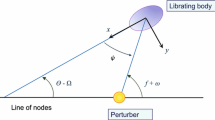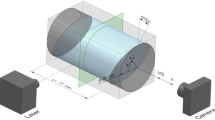Abstract
We give an analytic expression of the braking torque on a Jacobian ellipsoid rotating steadily in an environmental gas, based on the assumption that the ellipsoid rotates around its shortest principal axis with an angular momentum slightly larger than that at the bifurcation point of the Maclaurin spheroid. This braking torque is effected by the gravitational interaction between the ellipsoid matter and a spiral density configuration in the environmental gas. This spiral configuration, which we call a tidal acoustic wave, is caused by the zone of silence effect in a supersonic flow. With respect to a coordinates system rotating with the ellipsoid, a supersonic region appears outside a certain radius. In this supersonic region, the effect of the non-axisymmetric fluctuation in the ellipsoid potential propagates only along the downstream branches of the Mach waves. This one-sided response of the supersonic part causes the tidal acoustic wave. We restrict ourselves to the equatorial plane, and use an acoustic approximation of the basic equations under the assumption that the self-gravity effect of the environmental gas is negligible in comparison to the main gravity of the ellipsoid. The results are applied to the pre- and post-Main Sequence phases of a rotating star, and relating astrophysical problems are discussed.
Similar content being viewed by others
References
Batten, A. H.: 1973,Binary and Multiple Systems of Stars, Pergamon Press, Oxford, p. 196.
Biermann, L.: 1948,Z. Astrophys. 25, 161.
De Vaucouleurs, G. and Freeman, K. C.: 1972, in A. Beer (ed.),Vistas in Astronomy, Pergamon Press, Oxford, Vol. 14, p. 163.
Hayashi, C., Hōshi, R., and Sugimoto, D.: 1962,Prog. Theor. Phys. Suppl. 22, 165.
Jeans, J.: 1928,Astronomy and Cosmology, Dover Publ. Inc., New York, p. 206.
Kippenhahn, R., Meyer-Hofmeister, E., and Thomas, H. C.: 1970,Astron. Astrophys. 5, 155.
Mammano, A., Margoni, R., and Stagni, R.: 1974,Astron. Astrophys. 35, 143.
Roxburgh, I. W.: 1965,Astrophys. J. 143, 111.
Sugimoto, D. and Nomoto, K.: 1974, in R. J. Tayler (ed.), ‘Late Stages of Stellar Evolution’,IAU Symp. 66, 105.
Von Kármán, T.: 1947,J. Aeron. Sci. 14, 373.
Author information
Authors and Affiliations
Rights and permissions
About this article
Cite this article
Sakurai, T. Anguilar momentum transport by tidal acoustic wave. Astrophys Space Sci 41, 15–25 (1976). https://doi.org/10.1007/BF00684569
Received:
Issue Date:
DOI: https://doi.org/10.1007/BF00684569




